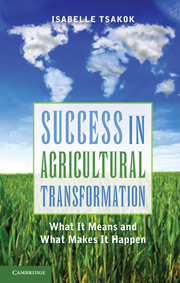Book contents
- Frontmatter
- Contents
- Figures and Table
- Preface
- Acknowledgments
- Summary
- Introduction
- Part One The many faces of agricultural transformation in an industrializing world and what it means
- Part Two Success in Agricultural Transformation: What Makes It Happen?
- III Necessary Conditions
- IV Necessary but Not Sufficient Conditions?
- V Missing Conditions
- VI The Public Foundations of Private Agriculture
- Appendices
- Select Bibliography
- Index
IV - Necessary but Not Sufficient Conditions?
from Part Two - Success in Agricultural Transformation: What Makes It Happen?
Published online by Cambridge University Press: 05 June 2012
- Frontmatter
- Contents
- Figures and Table
- Preface
- Acknowledgments
- Summary
- Introduction
- Part One The many faces of agricultural transformation in an industrializing world and what it means
- Part Two Success in Agricultural Transformation: What Makes It Happen?
- III Necessary Conditions
- IV Necessary but Not Sufficient Conditions?
- V Missing Conditions
- VI The Public Foundations of Private Agriculture
- Appendices
- Select Bibliography
- Index
Summary
Introduction
Summary. Only during the last decades of the 20th century were Ireland and Portugal finally able to put together the five conditions. An important condition is related to the landownership structure. Although both Ireland and Portugal ended the 20th century with predominantly private ownership, there were other structural features that tended to undermine incentives for long-term tenancies and investments in agricultural productivity. The cases of Ireland and Portugal do not refute the hypothesis that the five conditions are necessary. However, their experiences do emphasize the importance of two other factors for successful transformation: (a) the age structure and educational makeup of the farming population and (b) the long time – more than two to three decades – necessary for achieving broad-based high productivity and improved incomes for the majority of farm/rural families. Indeed, a review of selected worldwide experiences shows that the time dimension varies substantially across countries.
- Type
- Chapter
- Information
- Success in Agricultural TransformationWhat It Means and What Makes It Happen, pp. 213 - 232Publisher: Cambridge University PressPrint publication year: 2011



